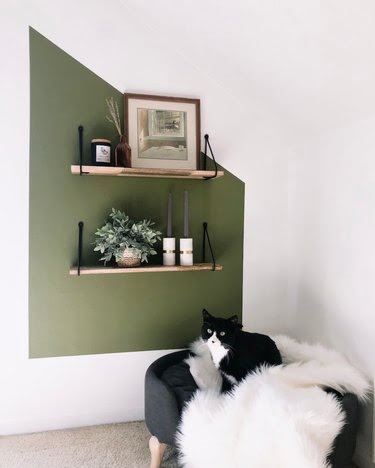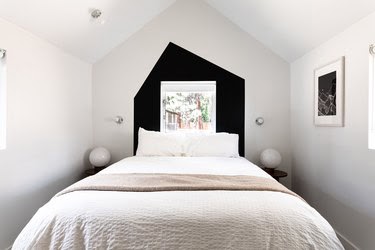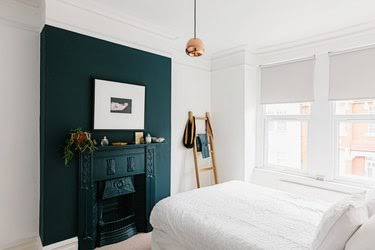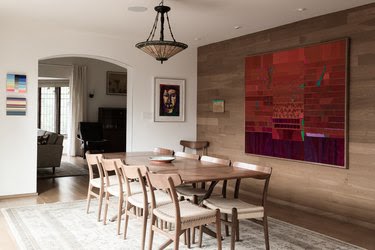Quck answer
1. Choose a focal point: Select a wall that naturally draws attention, such as one with a fireplace or large window.
2. Consider the room’s purpose: Use a bold color or pattern for an accent wall in a living room or bedroom, but opt for a more subtle choice in a workspace or kitchen.
3. Complement the existing color scheme: Pick a color that coordinates with the room’s current palette to create a cohesive look.
4. Use a contrasting color: For a dramatic effect, choose a color that is opposite on the color wheel from the room’s main color.
5. Play with patterns: Consider using wallpaper or stencils to add texture and visual interest to your accent wall.
6. Think about scale: If your room is small, opt for a lighter color or a smaller pattern to avoid overwhelming the space.
7. Test your choice: Use paint samples or wallpaper swatches to see how your chosen color or pattern looks in different lighting conditions.
8. Don’t forget about lighting: Consider how the accent wall will be affected by natural light and artificial lighting sources in the room.
9. Pay attention to furniture placement: Arrange your furniture in a way that enhances the impact of the accent wall and creates a balanced look.
10. Have fun and experiment: Don’t be afraid to take risks and try something new. The accent wall is an opportunity to showcase your personal style and creativity.
When it comes to decorating your home, it’s important to create a space that reflects your personality and makes you feel comfortable. While choosing furniture, lighting, and accessories can achieve this, don’t forget about your walls. Committing to a paint color for an entire room can be overwhelming, especially if you want to try something bold. That’s where an accent wall comes in.
So, what exactly is an accent wall? It’s a vertical surface, either inside or outside, that has a different color, design, or material compared to the other walls. Adding an accent wall not only adds a fun element to your home decor, but it also makes for a smart design choice. An accent wall can act as a focal point in any room, bring balance to a bright and airy space, visually separate different areas in an open layout, and even create the illusion of a headboard or draw attention to a picture window. It’s not just about painting one wall a contrasting color; you can experiment with patterns, textures, wallpaper, tile, or a gallery wall.
However, the challenge lies in deciding which wall should be the accent wall. Here are some tips to help you make the best choice for your home:
How to Choose an Accent Wall
1. Choose a wall that naturally attracts attention.

Image Credit:
Stephen Paul for Hunker
Consider the function of the room when selecting a focal wall. Which area do you want to draw attention to? In the living room, it’s usually where the TV is placed. Creating a dark accent wall, such as black or navy blue, can provide a dramatic backdrop for your favorite shows, making the TV almost disappear.
2. Make the most important furniture piece stand out.

Image Credit:
Stephen Paul for Hunker
If you have a lot of empty wall space, an accent wall can anchor your design. In this bedroom example, the soft green color serves as a cozy backdrop that complements the natural light from the large windows and the lush landscape outside. The use of wood features and soft textures enhances the warm and inviting atmosphere. For bedrooms, opt for soothing or pastel shades, while bolder tones can be used in the living and dining areas.
3. Create depth in a narrow room.

Image Credit:
Hunker in Partnership With Acme Real Estate
To add drama and depth to any room, consider incorporating the color black. This stylish setup combines natural finishes and neutral textiles with an edgy accent wall. While the bedroom design would still work if the wall was left white, the addition of ebony paint elevates the space and gives it a whole new look and feel.
4. Define your space visually.

Image Credit:
Stephen Paul for Hunker
Many of us live in homes or apartments with open floor plans or multipurpose rooms. For example, if your home doesn’t have a designated entryway, you can create one by adding an accent wall. Instead of using paint, you can mount wood slats on the wall and ceiling, as shown here, to create a unique and textured finish that adds visual interest. And if you want to make a grand entrance, you can add planters, a bench, and throw pillows to define your space and welcome guests.
5. Conceal a doorway.

Image Credit:
ThreeSixNine
Living in a loft or studio apartment can present challenges when it comes to decorating, especially in large open spaces. That’s why we love this accent wall from Joy of ThreeSixNine. Not only is the design inspiring, but it also shows that with a little creativity, you can make the most of awkward layouts. Here, Joy was able to hide the door in plain sight using a playful palette and artistic color blocking.
6. Highlight a specific area instead of the entire wall.

Image Credit:
Heena Gardner
When choosing an accent wall, remember that you don’t have to cover the entire wall to make a big impact. You may just want to draw attention to a specific area. In that case, take inspiration from Heena Gardner and highlight a small section. She chose a muted shade of olive green to complement her bookshelves and add some flair to a cozy corner. Have fun with it and paint a shape on your wall to give an otherwise plain wall some extra character.
7. Frame the window.

Image Credit:
Stephen Paul for Hunker
A window with a picturesque view is the perfect idea for an accent wall in any home. It’s also the easiest way to bring the outdoors inside. As shown in this black-and-white bedroom color scheme, framing your window with a little wall paint ensures that the beautiful scenery gets the attention it deserves. And as a bonus, you can add a whimsical touch to your space by incorporating the lines of your home’s unique architecture.
8. Make the fireplace the focal point.

Image Credit:
Alex Reyto
If you have a fireplace or built-in bookcase in your home, consider turning it into an accent wall. For example, we love the dark teal tone-on-tone treatment used on the fireplace and the wall behind it in this bright, light-filled bedroom. The dramatic focal point makes a powerful impact without overwhelming the airy design and eliminates the need for much else in terms of home decor.
9. Emphasize a small area.

Image Credit:
Stephen Paul for Hunker
Accent walls don’t have to be large to make a big impact. Look at this forest green nook framed by damask-patterned wallpaper. The combination of a bold color and an eye-catching pattern can add drama and depth to any space. And the rich jewel tone of the adjacent ottoman perfectly complements this small but impactful alcove that resembles a sophisticated salon or speakeasy.
10. Enhance your dining table with a stunning background.

Image Credit:
Stephen Paul for Hunker
An accent wall can transform your dining area, especially if you have a long empty wall that needs some special attention. Think of this blank space as the backdrop for your tablescape, and use it to anchor the entire room. In this setup, the wood paneling adds warmth and texture that beautifully complements the furniture and flooring. To complete the look, add a striking piece of wall art that will spark conversations at your next dinner party.
Key Points to Consider

Image Credit:
Peter Schweitzer
When choosing which wall to turn into an accent wall, ask yourself: What do I want to see as soon as I enter the room? Once you have the answer, the rest is straightforward. However, before making a final decision, keep these important factors in mind:
- Select a wall that will be visible and make a significant impact, rather than one that will be hidden.
- Choose a paint color or material that complements and enhances the rest of your decor.
- Consider the overall atmosphere you want to create. Do you prefer something bold and exciting, dark and moody, or warm and earthy?
- Do you want to cover the entire wall? Remember that you can focus on a small section and still make a statement. Experiment with shapes and textures for an even bolder effect.
- Instead of solely focusing on the walls, think about highlighting architectural features such as a fireplace, window, door, nook, or built-in bookcase.

